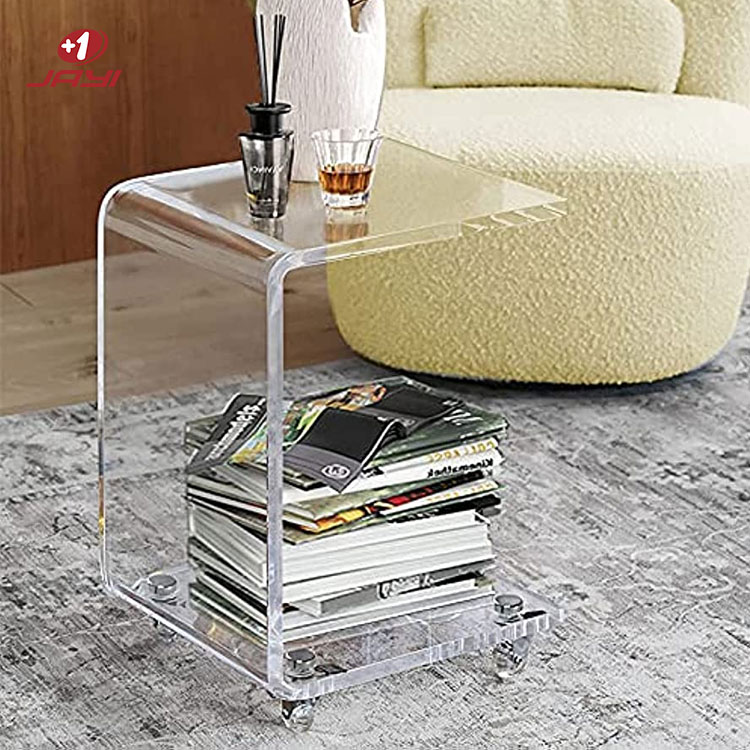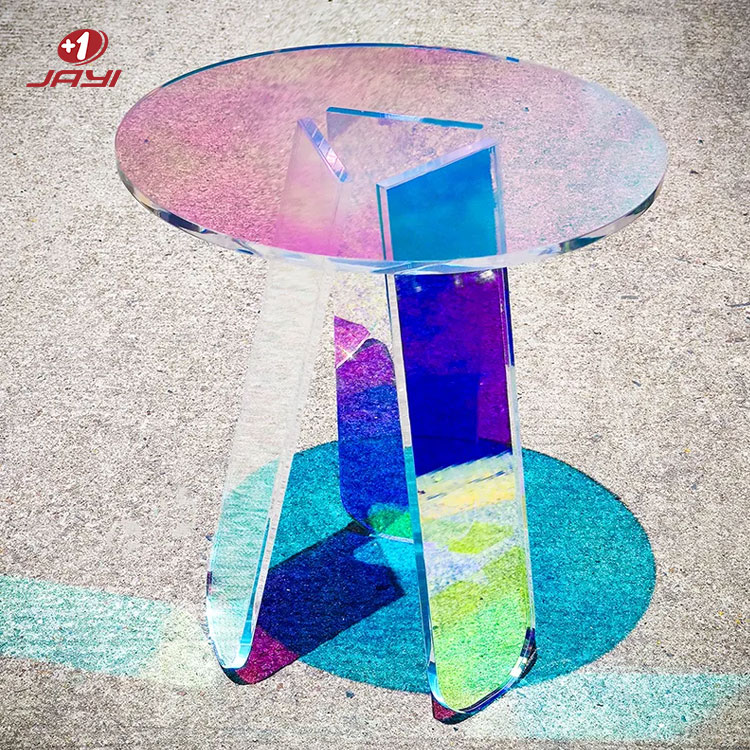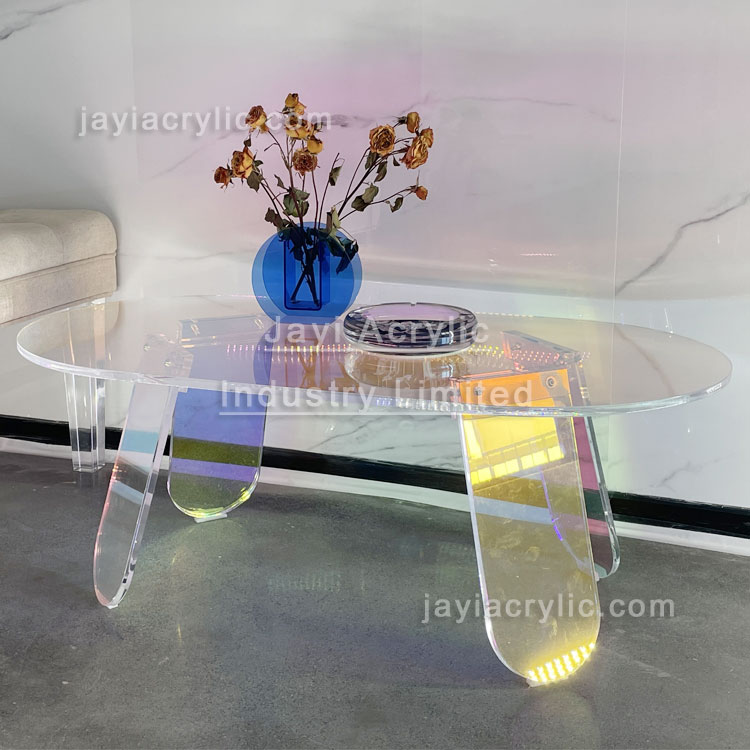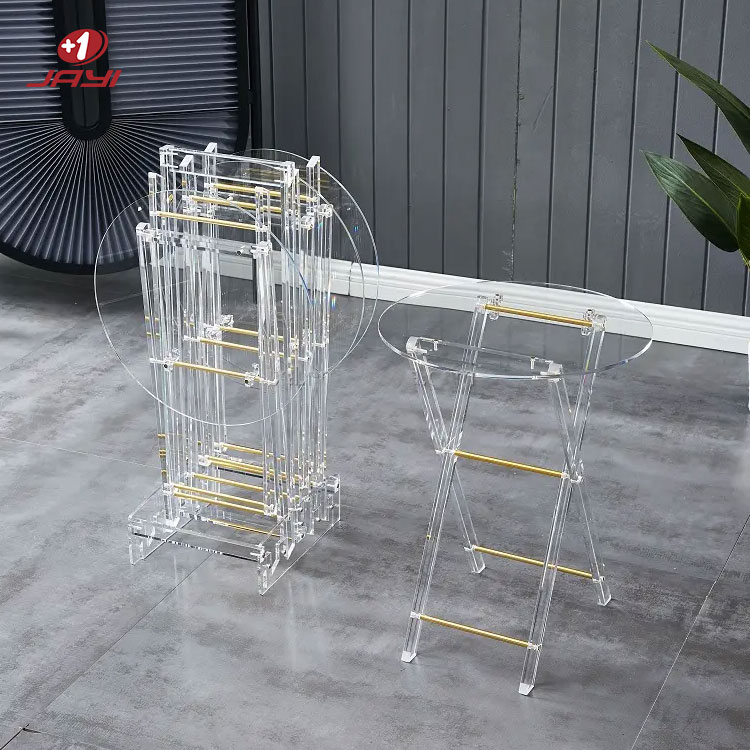Acrylic tables as a kind of fashionable, modern furniture, in recent years, the demand in the market is increasing. Traditional standardized furniture has been unable to meet people's pursuit of personalization and uniqueness, so customized acrylic tables have gradually become a popular choice. Customized acrylic tables can meet the individual needs of customers for size, shape, color, and other aspects while showing the brand image and unique style. This paper aims to introduce the price calculation method of customized acrylic tables in detail to help customers understand various factors and expenses in the customization process and provide them with a clear price reference.
Through this article, you will understand the market demand and importance of acrylic table customization, and understand the price calculation method of customized acrylic tables. We will explore the impact of material cost, process cost, size and design complexity, and quantity demanded and order size on price. In addition, we will cover pricing strategies and market competition considerations to help you develop a sound pricing strategy in a competitive market.
If you are a consumer looking to customize a unique acrylic table, then this article will provide you with detailed professional information and guidance. Let's dive into the price calculation method for acrylic table customization to help you better understand the complexity and flexibility of this process.
Acrylic Table Custom Price Factor
A. Material Cost
The price of acrylic table customization is affected by the cost of the acrylic sheet used. Acrylic sheet is the main material to make acrylic tables, and the choice of its type and brand will affect the price. The following are some common types and characteristics of acrylic sheet:
Standard Acrylic Sheet: Standard acrylic sheet is the most common type, with good transparency and weather resistance. It is available in all sizes and thicknesses and is relatively affordable.
High-transparency Acrylic Sheet: High-transparency acrylic sheet can provide higher transparency and optical quality, so that the desktop looks more clear and bright. Due to the improvement of its manufacturing process and material characteristics, the price of high transparency acrylic sheet is usually higher than that of standard acrylic sheet.
Colored Acrylic Sheets: Colored acrylic sheets have different color and texture options, which can add personalized visual effects to custom acrylic tables. The price of colored acrylic sheets may vary depending on the rarity of the color and the difficulty of manufacturing.
Special Effects Acrylic Sheet: Special effects acrylic sheet includes matte, reflective, metal film, etc., which can give the acrylic table more texture and special effects. These special effects acrylic sheets are usually more expensive because the manufacturing process requires more craftsmanship and technology.
In addition to the different types of acrylic sheets, the choice of the brand will also have an impact on the price. Acrylic sheets of well-known brands usually have higher quality and reliability, but their prices will increase accordingly. Therefore, when choosing acrylic sheet, it is necessary to consider the budget and the required quality criteria.
Understanding the characteristics of different types and brands of acrylic sheets and their impact on price can help you make an informed choice of materials when customizing an acrylic table. Next, we will continue to explore other factors that affect the price of acrylic table customization.
Whether you wish to customize a table in a simple, modern style or a unique and innovative design, we can meet your needs. Our craftsmen are experienced in acrylic material handling and can bring your imagination to life. Contact us to discuss your design ideas.
B. Process Cost
Custom acrylic tables need to go through a series of processing processes and steps. The following are the common process steps required to make an acrylic table, and explain how each step affects the price:
Cutting and Cutting Shape: The acrylic sheet needs to be cut and shape cut according to the design requirements. This step involves the use of laser cutting or mechanical cutting equipment to make precise cuts according to the size and shape of the table. Complex cut shapes and large-size tabletops may require more time and accuracy and thus may increase the process cost.
Sharpening and Polishing: The cut edges need to be sharpened and polished to make them smooth and secure. This step involves the use of sandpaper, grinding stones, and polish to remove sharp parts of the edges and improve the smoothness. The number and length of edges will affect the process cost of edge-grinding and polishing.
Gluing and Fixing: The assembly of acrylic tables usually requires the use of special acrylic glue and fixing pieces. This step involves gluing the different components together and using fixed pieces to ensure the stability of the structure. Complex designs and structures may require more bonding and fixation, thus increasing the process cost.
Carving and Custom Details: Depending on the design requirements, acrylic tables may need to be carved and custom details added. This step involves the use of laser engraving or mechanical engraving equipment to create specific patterns, words, or decorations. Complex carving and custom details will increase the process cost.
Surface Treatment and Painting: In order to increase the wear resistance and beauty of the acrylic table, surface treatment and painting are necessary steps. This step involves the use of special surface treatment agents and coatings to increase the smoothness, scratch resistance, and yellowness resistance of the acrylic table. Different surface treatment and coating options will have an impact on the process cost.
The complexity of each process step and the required level of time and technology have an impact on the process cost. More complex designs, large-size tabletops, unique carving and custom details, and special surface treatment requirements can all lead to higher process costs. Therefore, when customizing the acrylic table, it is necessary to consider the design requirements and budget comprehensively to ensure the rationality of the process cost.
In the next section, we will discuss other factors in the price calculation of acrylic table customization, including size and design complexity as well as quantity demanded and order size.
C. Size and Design Complexity
Impact of Size on Price: The size of the acrylic furniture table is an important consideration in the customization process, which will directly affect the price. Usually, larger sizes of acrylic tables require more materials and processing techniques, so the price will increase accordingly. In addition, larger acrylic sheets may be more difficult to obtain, further increasing the cost. Therefore, when customizing acrylic tables, the choice of size should be balanced with the budget and needs.
Impact of Design Complexity on Price: Design complexity is another important factor that affects the price of acrylic table customization. Complex design requirements, such as curved shapes, special structures, irregular edges, etc., usually require more processing steps and techniques, thus increasing the process cost. For example, making an acrylic table with curved edges may require the use of specialized tools and techniques to achieve smooth curves, which increases the complexity and cost of processing. Therefore, the design complexity needs to consider the budget, technical requirements, and fabrication feasibility.
Overall, acrylic tables with larger sizes and complex designs generally lead to higher custom prices. When determining the size and design of an acrylic table, a combination of budget, demand, and feasibility needs to be considered to ensure that the final customized solution is within the expected price range.
Our professional team will provide you with full service throughout the customization process, from design, and production to installation, we will pay careful attention to every detail to ensure that everything is done according to your expectations. If you have any questions or concerns, please feel free to ask us.
D. Demand and Order Size
Price Advantage for Mass Customization and Large Orders: Price advantages are usually obtained when the demand is large and the order size is large. This is because mass production can realize production benefits and economic scale improvement, which reduces the cost per unit of product. Suppliers can reduce costs by optimizing production processes, reducing material waste, improving process efficiency, and translating these cost advantages into more competitive prices.
The Price Factor of Small Batch or Individual Customization: In contrast, the price of small batches or individual customization will usually be higher. This is because there are more challenges in small batch production, including adjustments and Settings during production, the risk of material waste, and the uniqueness of customization requirements. These factors may lead to a decrease in production efficiency and an increase in costs, which in turn affects prices. In addition, individual customization may also require special processes and technologies, further increasing the cost.
For small batches or individually customized acrylic tables, suppliers may need to consider the price increase caused by the following factors:
Production Adjustments and Settings: For different customization needs, suppliers may need to adjust production lines and equipment Settings to accommodate different designs and specifications. These adjustments and Settings may require additional time and cost, thus increasing the price.
Special Materials Procurement: Individual customization may require special acrylic sheets or other materials, which may be relatively expensive or difficult to obtain. The procurement cost of special materials can affect the price of the final product.
Handcrafting and Custom Processes: Individual customization may require more manual operations and custom processes, such as hand carving, custom painting, etc. These processes may require more labor and time, thus increasing the price.
Unique Design and Requirements: Individual customization often requires specific design and customization requirements, which may require additional design effort and engineer involvement from the vendor. These additional design and engineering costs have an impact on the price.
As a result, small batches or individually customized acrylic tables tend to be relatively expensive. When considering custom acrylic tables, make a reasonable assessment of your budget and make a trade-off between demand and order size to get the best price and satisfaction.
In summary, the price of acrylic table customization is affected by many factors such as material cost, process cost, size and design complexity, and demand and order size. When making acrylic table customization, considering these factors comprehensively and fully communicating with the supplier can help you obtain satisfactory customized products and prices.
If you are in business, you may like
Acrylic Table Custom Price Calculation Method
A. Material Costing
Acrylic sheets are usually priced in square feet or by weight. The following is an introduction to these two pricing methods and an example of calculating the cost of an acrylic sheet:
In Square Feet:
It is common for acrylic sheets to be calculated by surface area (square feet). This pricing method is suitable for projects that need to consider the size and area of the material.
Example: Suppose the price of an acrylic sheet is $10 per square foot and you need to purchase an acrylic sheet with dimensions of 4 feet x 6 feet.
First, calculate the area: 4 feet x 6 feet = 24 square feet
Then, multiply the size by the price: 24 square feet x $10 / square foot = $240
Therefore, the cost of purchasing an acrylic sheet of this size would be $240.
By Weight:
Another way of pricing is calculated according to the weight of the acrylic sheet. This pricing method is suitable for projects that need to consider the density and weight of the material.
Example: Suppose the price of an acrylic sheet is $5 per pound and you need to purchase an acrylic sheet that weighs 20 pounds.
Simply multiply the weight by the price: 20 LBS x $5 / lb = $100
Therefore, purchasing this weight acrylic sheet will cost $100.
Please note that actual acrylic sheet prices may vary depending on vendor, region, thickness, color, and other factors. This is just an example and you should consult the actual vendor for accurate pricing and pricing when purchasing.
Pricing Strategy
There are many common pricing strategies. Here are some of them and how to set a reasonable price in a competitive market:
Cost Plus Method:
Cost-plus is a cost-based pricing strategy that adds the cost of a product or service together with the expected profit to determine the final price. This strategy is generally applicable to manufacturing and service industries, where cost calculation and control are relatively explicit.
Market Pricing Method:
The market pricing method is a pricing strategy based on market demand and competition situation. It takes into account the degree to which customers are willing to pay for a product or service and the pricing strategies of competitors. The market pricing method can be divided into the following methods:
Market-oriented pricing: Determining price according to market demand and competitive conditions to meet customer needs and gain competitive advantage.
Brand pricing: Set prices based on brand value and market recognition. Well-known brands can often set higher prices.
Differentiated pricing: The development of different pricing strategies based on different characteristics, added value, or positioning of products or services.
Pricing Elasticity Method:
The pricing elasticity method is a pricing strategy based on price elasticity. Price elasticity refers to the sensitivity of price changes to changes in quantity demanded. Depending on the price elasticity of a product or service, the following strategies can be adopted:
Flexible pricing: Flexible pricing is based on price elasticity to increase sales volume or market share.
Price fixing: For products or services that are not price sensitive, relatively stable pricing can be maintained.
Ways to set reasonable prices in a competitive market include:
Competitive analysis: Understand the pricing strategy, product characteristics, and market share of competitors. This can help you determine where your product or service stands and how competitive it is in the market and develop a pricing strategy accordingly.
Customer research: Conduct market research to understand customer needs, preferences, and price sensitivity. By understanding the value cognition of customers to products or services, relatively reasonable prices can be set to balance customer needs and profit requirements.
Value-added pricing: Consider the added value of a product or service, such as quality, functionality, service, and after-sales support. If your product or service provides additional value, the price is higher accordingly.
Pricing experiments: Pricing experiments can be conducted to test the impact of different price levels on sales volume and profit. By observing the market reaction and customer behavior, the price is gradually adjusted to achieve the best pricing strategy.
It should be noted that pricing decisions should consider multiple factors, including cost, market demand, competitive situation, customer behavior, and target profit. Flexibility and continuous market monitoring are also key to setting reasonable prices.
Our acrylic table custom factory always insists on using high-quality materials to ensure that each table can stand the test of time. Our products are not only aesthetically pleasing but also have outstanding durability. For more information about our products and craftsmanship, please feel free to contact us.
Summary
In this paper, we discuss pricing strategies and methods for setting reasonable prices in competitive markets. We introduce common pricing strategies, including cost-plus and market-based pricing, and discuss methods for setting reasonable prices in competitive markets, such as competition analysis, customer research, and value-added pricing.
Regarding the complexity and flexibility of customized pricing for acrylic tables, we highlight the following points and conclusions:
Pricing Complexity of Custom Products:
Acrylic table customization is a highly personalized service, and its pricing is affected by many factors. These factors include material cost, manufacturing process, design complexity, special requirements, and the customer's budget and willingness to pay. Therefore, the pricing of customized products is often more complex and requires a combination of multiple factors.
The Importance of Flexible Pricing:
Due to the particularities of customized products, the price elasticity may vary. For some customers, they may pay more attention to the quality and uniqueness of the product and are willing to pay a higher price. For other customers, they may pay more attention to the competitiveness of the price. Therefore, it is crucial to flexibly adjust the price and make flexible pricing according to the demand of different customers and the market reaction.
Personalized Pricing Strategy:
In order to meet the needs of different customers and remain competitive, acrylic table customizers can consider personalized pricing strategies. This includes pricing based on the customer's specific requirements and special needs, providing customized options and value-added services, and flexible pricing based on the customer's budget and value perception.
Continuous Market Monitoring and Adjustment:
As the market environment and competitors change, acrylic table customizers need to carry out continuous market monitoring and adjust their pricing strategies accordingly. Paying close attention to changes in market trends, competitor pricing, and customer needs can help them stay competitive and adapt to changes in the market.
In summary, the pricing of acrylic table customization is a complex and flexible process. By considering material cost, manufacturing process, design complexity, special requirements, customer budget and desires, adopting flexible pricing and personalized pricing strategies, and continuous market monitoring and adjustment, acrylic table customizers can remain competitive in a competitive market.
Post time: Aug-14-2023




